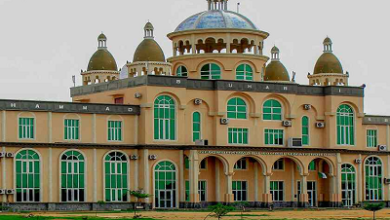NECO Human and Regional Geography Essay 2023 Questions and Answers

The National Exam Council (NECO) is scheduled to administer the Human and Regional Geography paper on Tuesday, 1st August 2023. In this article, we will provide detailed answers for the NECO Geography Paper II Essay section, which will take place from 3:00 pm to 5:00 pm. Aspiring candidates can refer to the resources provided here to gain a better understanding of the expected standards for the Geography final examination.
Section 1: Settlement Types and Factors Influencing Urban Growth
1. Characteristics of Settlement Types
(a) Village:
- Village settlements are characterized by small populations and a close-knit community.
- Typically, they have limited infrastructure and basic amenities.
- Agricultural activities form the primary source of livelihood for the residents.
(b) Town:
- Town settlements have larger populations compared to villages.
- They offer a wider range of services and amenities, including schools, hospitals, and markets.
- Economic activities are more diverse, with a mix of agricultural, industrial, and commercial sectors.
2. Factors Influencing Urban Growth
Urban centers experience growth due to various factors, including:
- Economic opportunities: The presence of industries, job opportunities, and a higher standard of living attract people to urban areas.
- Infrastructure development: The availability of better infrastructure, such as roads, electricity, and communication networks, contributes to urban growth.
- Social amenities: Urban centers offer better access to education, healthcare, entertainment, and recreational facilities.
- Migration: People may move to urban areas in search of better opportunities and improved living conditions.
Section 2: Key Concepts in Geography
1. Great Circle
A great circle is the shortest distance between any two points on the surface of a sphere. It represents the intersection of a sphere with a plane that passes through its center. Great circles are important in navigation and aviation for determining the shortest routes between two locations on Earth.
2. Greenwich Mean Time (GMT)
Greenwich Mean Time (GMT) is the standard time at the Royal Observatory in Greenwich, London. It is used as a reference point for calculating time zones around the world. GMT is based on the Earth’s rotation and is used as a standard time for various purposes, including international timekeeping and coordination of global activities.
3. Twilight
Twilight refers to the period of time before sunrise and after sunset when the sky is partially illuminated. It is divided into three stages: civil twilight, nautical twilight, and astronomical twilight. During twilight, there is still enough light for outdoor activities without the need for artificial lighting.
4. Dawn
Dawn is the time of day when the first light appears in the sky before sunrise. It marks the transition from night to day and is often associated with the beginning of a new day. Dawn is a beautiful and serene time, with colors gradually changing in the sky as the sun rises.
5. International Date Line
The International Date Line is an imaginary line that roughly follows the 180° meridian. It serves as the dividing line between two consecutive calendar days. When crossing the International Date Line from east to west, you move back one day, and when crossing from west to east, you move forward one day.
Section 3: Compass Traversing and Sources of Error
1. Back Bearing
Back bearing refers to the direction opposite to the forward bearing of a line. It is determined by adding 180° to the forward bearing. Back bearings are used in compass traversing to ensure accurate navigation and to retrace the steps taken during a journey.
2. Procedure for Compass Traversing
The procedure for compass traversing involves the following steps:
- Set up the compass on a level surface and ensure it is properly aligned with the magnetic north.
- Take a forward bearing in the desired direction and note the angle.
- Measure the distance traveled in that direction.
- Repeat the process for subsequent legs of the journey, noting the bearings and distances.
- Calculate the back bearings by adding 180° to the forward bearings.
- Plot the traversed course on a map using the bearings and distances recorded.
3. Sources of Error in Compass Traversing
There are several sources of error in compass traversing, including:
- Magnetic declination: The difference between magnetic north and true north can cause variation in compass readings.
- Local attraction: The presence of magnetic materials or electrical equipment in the vicinity can affect the accuracy of compass readings.
- Inaccurate measurements: Errors in measuring distances or recording bearings can lead to inaccuracies in compass traversing.
Section 4: Factors Affecting Temperature and Relief Rainfall
1. Effects of Latitude on Temperature
Latitude refers to the distance of a location from the equator. It has a significant influence on temperature. The effects of latitude on temperature include:
- As latitude increases (moving away from the equator), temperatures generally decrease.
- Areas near the equator experience high temperatures throughout the year due to the direct overhead position of the sun.
- Areas closer to the poles have lower temperatures, as the sun’s rays are more spread out and less intense.
2. Effects of Continentality on Temperature
Continentality refers to the distance of a location from the moderating influence of the ocean. It affects temperature in the following ways:
- Coastal areas experience milder temperatures due to the moderating effect of the ocean.
- Inland areas, far from the coast, are subject to more extreme temperature variations, with hotter summers and colder winters.
- The absence of large water bodies leads to less moisture in the air, resulting in drier climates.
3. Formation of Relief Rainfall
Relief rainfall occurs when moist air is forced to rise over elevated landforms, such as mountains. The process of relief rainfall formation involves the following steps:
- Moist air encounters a mountain range, forcing it to rise.
- As the air rises, it cools, causing the moisture to condense and form clouds.
- Condensation continues as the air reaches higher altitudes, leading to precipitation in the form of rainfall.
- The leeward side of the mountain experiences a rain shadow effect, with drier conditions due to the descending air.
Section 5: Formation and Types of Deltas
1. Conditions Favoring Delta Formation
Delta formation requires specific conditions, including:
- Active vertical and lateral erosion at the upper and middle courses of a river.
- Deposition of sediments formed from the upper and middle courses at the river mouth.
- The presence of a sheltered, tide-less coast to prevent the dispersion of sediments into deep waters.
- Absence of large lakes in the river course that could trap the sediments.
- No strong current at the river mouth to wash away the sediments.
2. Types of Deltas
Deltas can be classified into different types based on their shape and formation process. Some common types include:
- Arcuate: These deltas have a curved shape and are formed when river sediments are deposited in a fan-like pattern.
- Bird’s foot: These deltas resemble the shape of a bird’s foot and are formed when river sediments are distributed in multiple channels.
- Estuarine: These deltas form at the mouth of a river where it meets the sea, often characterized by a mix of fresh and saltwater.
- Cuspate: These deltas have a triangular shape and are formed when river sediments are deposited in a triangular pattern.
Section 6: Climate Analysis and Station A
1. Climatic Data for Station A
| Month | Temperature (°C) | Rainfall (mm) |
|---|---|---|
| J | 25 | 0 |
| F | 17 | 3 |
| M | 31 | 15 |
| A | 33 | 20 |
| M | 33 | 74 |
| J | 30 | 125 |
| J | 28 | 213 |
| A | 27 | 264 |
| S | 27 | 143 |
| O | 30 | 25 |
| N | 29 | 0 |
| D | 26 | 0 |
(a) Plotting Climatic Data Graph:
(b) Calculations for Station A: i. Annual Rainfall: Sum of monthly rainfall = 0 + 3 + 15 + 20 + 74 + 125 + 213 + 264 + 143 + 25 + 0 + 0 = 882 mm ii. Mean Annual Temperature: Sum of monthly temperatures / 12 = (25 + 17 + 31 + 33 + 33 + 30 + 28 + 27 + 27 + 30 + 29 + 26) / 12 = 29.25°C
(c) Climate Type for Station A: Based on the provided climatic data, Station A exhibits a tropical climate with high temperatures and distinct wet and dry seasons.
Section 7: Environmental Pollution and Its Effects
1. Definition of Environmental Pollution
Environmental pollution refers to the introduction of harmful substances or contaminants into the natural environment, resulting in adverse effects on living organisms and ecosystems. It can be caused by human activities, such as industrial processes, improper waste disposal, and emissions from vehicles.
2. Major Forms of Environmental Pollution
Four major forms of environmental pollution include:
- Air pollution: The release of harmful gases, particulate matter, and pollutants into the air, leading to respiratory problems and negative impacts on the environment.
- Water pollution: The contamination of water bodies, such as rivers, lakes, and oceans, with pollutants, chemicals, and waste, making it unsafe for human consumption and harmful to aquatic life.
- Soil pollution: The degradation of soil quality due to the presence of toxic substances, pesticides, heavy metals, and improper waste disposal, affecting plant growth and contaminating food sources.
- Noise pollution: The excessive and unwanted sounds that disrupt the environment, causing stress, hearing problems, and disturbances in wildlife habitats.
3. Effects of Environmental Pollution
Environmental pollution has various detrimental effects, including:
- Health issues: Exposure to polluted air, water, and soil can lead to respiratory problems, allergies, skin diseases, and even long-term health conditions.
- Ecosystem disruption: Pollution can harm biodiversity, disrupt ecological balance, and lead to the extinction of plant and animal species.
- Climate change: Certain forms of pollution, such as greenhouse gas emissions, contribute to global warming and climate change, leading to extreme weather events and environmental instability.
- Economic impact: Pollution can result in increased healthcare costs, reduced agricultural productivity, and damage to industries relying on natural resources.
- Social and cultural impacts: Pollution can degrade the quality of life, damage cultural heritage sites, and affect communities dependent on the environment for their livelihoods.
Section 8: Environmental Balance and the Water Cycle
1. Definition of Environmental Balance
Environmental balance refers to the state of equilibrium and harmony in ecosystems, where the interactions between living organisms and their environment are balanced. It involves maintaining biodiversity, minimizing pollution, and preserving natural resources for future generations.
2. The Water Cycle
The water cycle, also known as the hydrological cycle, is the continuous movement of water on, above, and below the Earth’s surface. It involves various processes, including evaporation, condensation, precipitation, and runoff. The water cycle is crucial for maintaining the Earth’s water resources and plays a vital role in various natural processes.
3. Importance of the Water Cycle to Man
The water cycle is essential to human life in several ways:
- Water supply: The water cycle ensures the availability of freshwater for drinking, irrigation, and industrial use.
- Agriculture: Precipitation and runoff from the water cycle provide the necessary water for crop growth and food production.
- Hydropower: The water cycle drives the generation of hydropower, a renewable energy source.
- Climate regulation: The water cycle helps regulate global climate patterns by redistributing heat and moisture.
- Ecosystem support: The water cycle sustains aquatic ecosystems, providing habitats for diverse plant and animal species.
Section 9: Geographical Description of Chad Basin
1. Relief and Drainage
The Chad Basin is characterized by a diverse relief and drainage system, including:
- Relief: The basin consists of low-lying plains, plateaus, and some low mountain ranges.
- Drainage: The main drainage feature is the Lake Chad Basin, which serves as a vital water source for surrounding countries. Several rivers, including the Chari, Logone, and Yobe, flow into the basin.
2. People, Population, and Settlement
The Chad Basin is home to various ethnic groups, including Kanuri, Hausa, Fulani, and Arab communities. The population is predominantly rural, with settlements scattered across the region. Livelihoods primarily revolve around agriculture, fishing, and pastoralism.
3. Economic Activities
Economic activities in the Chad Basin include:
- Agriculture: The fertile soils and availability of water resources support the cultivation of crops such as millet, sorghum, cotton, and vegetables.
- Fishing: The Lake Chad Basin provides a significant source of fish, supporting the local economy and food security.
- Pastoralism: Nomadic herding of cattle, sheep, and goats is a common economic activity in the region.
- Trade: The Chad Basin serves as a trade route, facilitating the exchange of goods between countries in Central Africa.
4. Problems of Development
The Chad Basin faces several challenges in terms of development, including:
- Water scarcity: The region experiences water scarcity due to shrinking water bodies and increased demand for irrigation and domestic use.
- Environmental degradation: Deforestation, overgrazing, and improper land use practices contribute to soil erosion and desertification.
- Political instability: Conflict and political instability in the region have hindered development efforts and led to displacement of communities.
- Poverty: The Chad Basin has high levels of poverty, limited access to basic services, and low human development indices.
Section 10: Conclusion
In conclusion, the NECO Human and Regional Geography Essay 2023 Questions and Answers provide valuable insights into various geographical concepts, settlement types, factors influencing urban growth, and the impact of environmental pollution. By understanding these topics, candidates can enhance their knowledge and prepare effectively for the upcoming examination. It is crucial to study the provided resources and engage in further research to gain a comprehensive understanding of Geography. Good luck to all the NECO candidates!
Remember, there are no shortcuts to success, and it is important to avoid fraudulent websites or individuals claiming to provide NECO Geography Expo online. Stay focused, study diligently, and trust in your abilities to excel in the examination.










